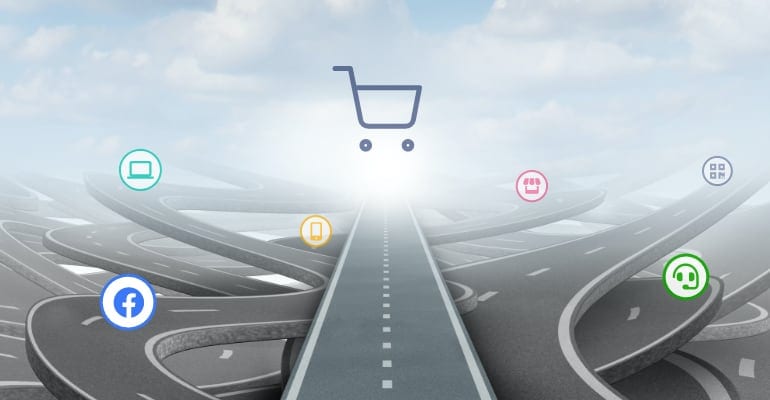“I see it. I like it. I want it. I got it”.
These lyrics from Ariana Grande’s 7 Rings may have topped the charts, but the customer journey is beyond outdated. Customers very rarely see something and immediately go to the checkout. The reality is a little more complicated.
Customers might see something they like on a billboard. Research it on a desktop computer. Be reminded of the product through a sponsored ad on their mobile – then finally go to a physical store to pick it up.
Conversions aren’t linear anymore. They’re complex, unique and ever-evolving. With the ability to buy however and whenever they prefer, conversions have become a complicated loop-de-loop of cross-journeys and platform-hopping.
To get a better view of how your customers are actually interacting with your brand, you need an omnichannel approach. Luckily, you can go omnichannel with Facebook advertising. You’ve just got to make sure you’re using the right tools and metrics.
What is omnichannel?
Omnichannel is a complete customer experience across multiple devices, channels and touchpoints, including both online and offline marketing.
Omni = all. So omnichannel is a fancy way of saying all channels. And you should get used to seeing this term.
And before you ask, omnichannel is different to multichannel.
Multichannel marketing uses various channels, such as PPC adverts, in-store promotions and video. But each of these channels are used independently of each other. There’s no relationship between them.
If you want an accurate picture of how the true customer journey looks, you need omnichannel marketing, not multichannel.
An omnipresent view with Facebook’s offline conversions
- 90% of sales still take place in-store – but people are discovering more products and brands online.
- 56% of in-store sales were influenced by digital interactions.
- 66% of these interactions were on mobile.
This just reinforces what we said before. The customer journey is not as linear as it used to be.
But it also exposes a fatal flaw in ways of measuring conversions online. Let’s say that Jessica sees that a local clothing store is selling adorable panda pyjamas online. She loves them and she’s in that area anyway. So, she goes in-store to try them on and buys them on the spot.
That’s a success for your business. But in terms of Facebook metrics, it’s a failure because Jessica didn’t click through and convert on your website.
With an omnichannel strategy, your business can recognise successes like this – and tweak your marketing to match.
You do this through Facebook’s offline conversions. This will, as the name suggests, incorporate the data of all conversions your business makes offline. You don’t need to manually upload this data either. Once you connect your offline data to Facebooks API, it will automatically connect to your POS or CRM system to refresh the data.
Once you have this data, you can also build separate audience lists based upon them.
This means that in place of sending her remarketing campaigns hoping she’ll finally come back and buy those panda pyjamas she already owns, you show her related products that she might also be interested in.
Instead of annoying her with something she’s already got, you’re helping to build a long-term loyal relationship. Nice.
Always looking out to the bigger picture
A Deloitte study from 2019 revealed that 87% of retail leaders agreed that an omnichannel strategy is critical to a business’s success.
Despite that, only 8% of them have an omnichannel strategy in place. Yikes.
But don’t be fooled into thinking that omnichannel is just for retail. If your business uses more than one marketing channel, whether that’s Facebook Ads, a website, social media, etc. You need an omnichannel strategy.
There is more than one way to create an omnichannel strategy with Facebook. It’s all about making sure the data is there.
As well as offline conversions, ensure that you have a Facebook pixel installed on your site to record customer behaviour. Monitor how people react on different devices and select attribution models that enable you to see the entire journey – not just the final click.
Omnichannel is more than a buzzword
Having an omnichannel strategy for your Facebook Ads is more than following the latest marketing trend.
It’s about making sure you’re able to see your marketing journey as a whole, not just looking at all the individual channels. If you want a well-oiled machine, all the parts need to work together.
Facebook tools and features like offline conversions, the Facebook pixel, and data attribution are there for you to get a more comprehensive view of your data. If you’re using a PPC optimisation tool, you need to ensure you select ones that support your omnichannel strategy.
Get creative, deliver great ads and look at the bigger picture with an omnichannel strategy. That’s the future of Facebook Ads success.
Featured image purchased & provided by Adzooma – source: https://www.bigstockphoto.com/image-68726122/stock-photo-clear-strategy
All in-article images provided and owned by Adzooma




